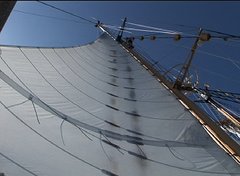Today I woke up for morning watch anticipating a call of
"Land ho!!" at some point in the following six hours. After three
days at sea, today was the day we were to make it to our next island stop, a
small island and coral atoll with, last we had heard, around 60 inhabitants.
Nearing land, anticipation on the ship was high, as crew members lined the
starboard rails, watching two small, metal boats belonging to local residents
help the Robert C. Seamans navigate the reef and find a place to drop
anchor.
 |
| Palmerston Beach |
The reef crest, exposed in the low tide, surrounded the island and
offered a jarring surface to imagine the sweet Bobby C. running aground, but of
course, those of us the rails paid it little attention except to marvel at its
beauty. Captain Pamela stood aloft on a
platform near the helm calling out orders to bring us safely to anchor, and
having just been relieved of watch, I was free to simply take in the scene
before me. The island on the starboard beam was covered in a dense tropical
forest of palm and mahogany trees with white coral sand beaches on its
perimeter. Beyond the reef crest, the lagoon shone a bright turquoise in
contrast with the deep blue of the pelagic waters with which I've become so
accustomed on this journey. In the preceding few hours, we had to fight our way
through a few squalls and some heavy rain, but the sun had just shown through,
making the colors shine a little bit brighter. A small rainbow appeared off the
port side of the ship. It was surreal upon arrival.
 |
| The welcome ceremony at Palmerston Island |
The island dead ahead of us was Palmerston - it, its reef,
and fringing islands a product of a sinking volcanic island over the last
millions of years. But in its more recent history, Palmerston has an intriguing
story (which I won't try to recount in detail without the fact checking power
of the internet, but for all you internet able folks on land, the Palmerston
Wikipedia page is worth a peruse). The island was settled by one man in the
1860's, and today, most of the permanent inhabitants are descended from him.
Never having visited such a secluded community, I
possessed no real sense of life on what was to me just a pretty little island
in the South Pacific, but a true homeland to its inhabitants. Luckily, we were
going to have the chance to find out.
 |
| Sunday lunch with Bill and Mietz Marsters |
After anchoring,
the boats that had guided us through the reef began shuffling us off the ship
and to the island for a welcome ceremony. As we approached the beach, our guide
exclaimed, "Welcome to Palmerston! This is the place for me," and it
wasn't a stretch to see why. The beauty was evident, and the people were
friendly. The welcome ceremony consisted of a song, a quick introduction, and
tour around the island by some enthusiastic younger inhabitants. As it turns
out, our visit, a near doubling of the islands population, is a big to do, so
almost everyone came out to say hello.
But in our short time on the island this evening, I couldn't help but
compare my own life to those who grew up here. The pace of life, the isolation,
even the complete reliance on religion seems so foreign to me. To view myself
as a child in their open air school house or living in one of the palm frond huts
was difficult. Being of the adventurous persuasion, I imagine most of us on the
ship can't imagine living on a small island for our entire lives. Yet, of
course, in each of our two groups, crew of the Bobby C. and inhabitants of
Palmerston, we found similarity almost immediately, and it wasn't a minute
before laughter and warm greetings filled the beach. The warm welcome we
received this first evening is extended to homestays over the next three nights
and a church service on Sunday. No doubt you will be hearing more about life on
Palmerston, in much greater detail than can be gleaned with our short visit
this evening. In the meantime, welcome to Palmerston!
 |
| Palmerston Church - Andrea and the RCS ladies in their hats |
Warm Wishes from the Robert C. Seamans,
-Lia






No comments:
Post a Comment